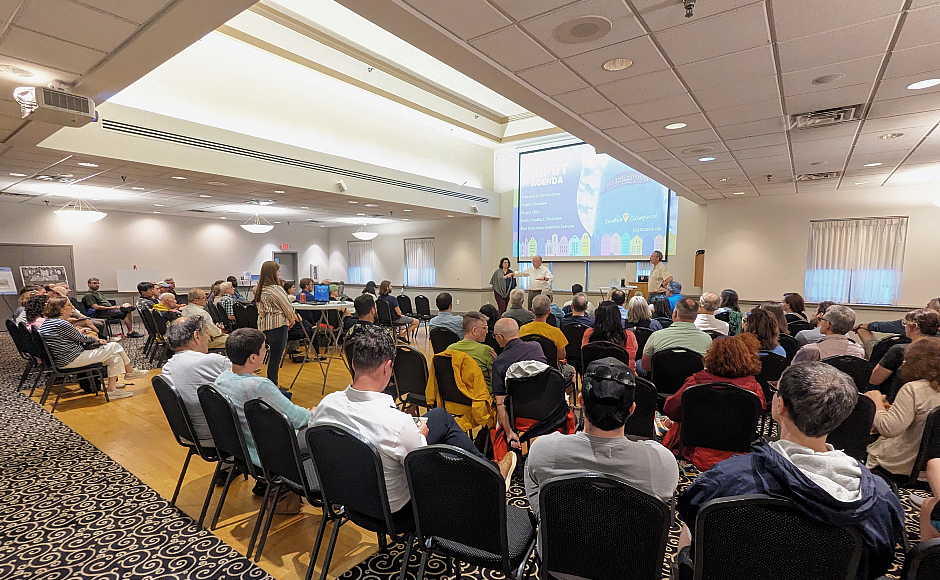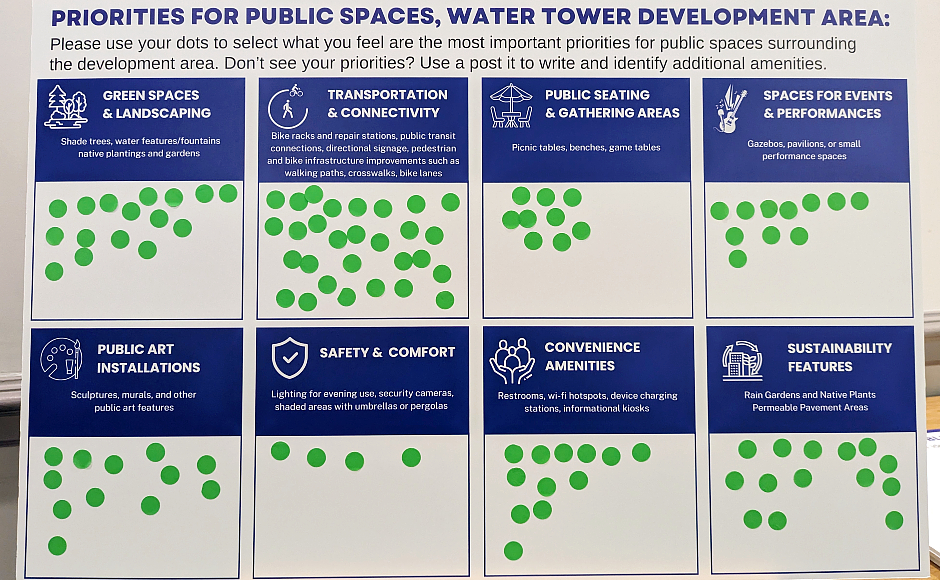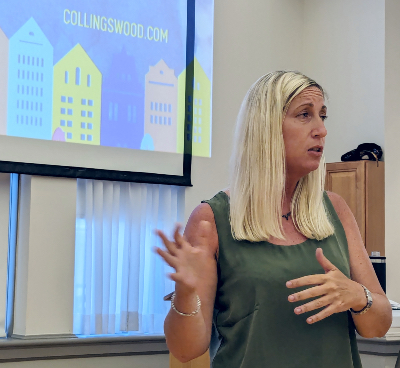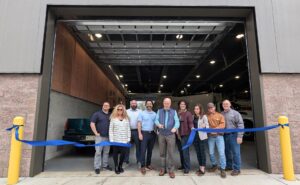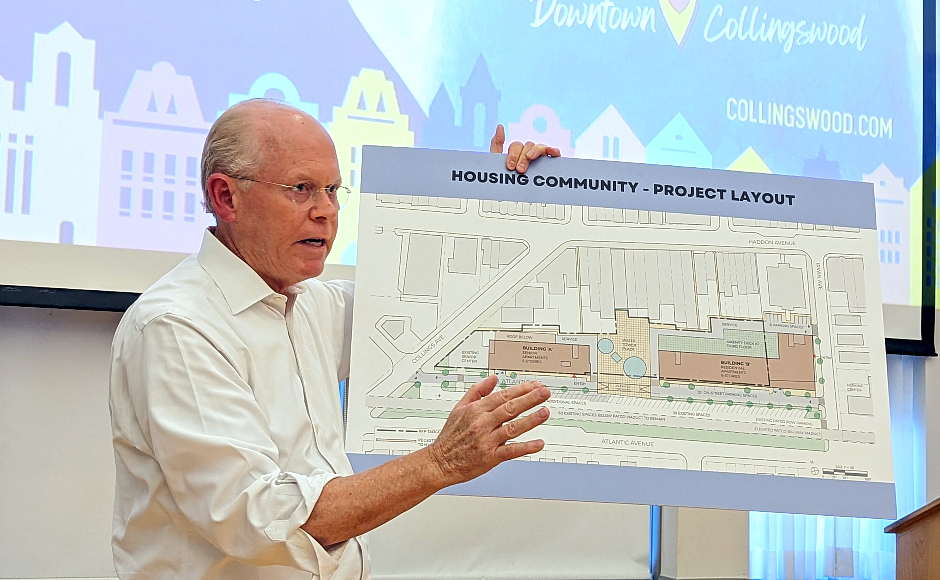
Collingswood Mayor Jim Maley discusses the water tower redevelopment project. Credit: Matt Skoufalos.
After naming a conditional redeveloper for its Atlantic Avenue “Water Tower” project, the Collingswood municipal government held the first of a pair of visioning sessions for the site May 29, hearing concerns, questions, and feedback from borough residents and the broader community.
The principal goal of the project, according to Collingswood Mayor Jim Maley, is to expand the ratable base of the community by improving the 1.8-acre blacktop lot bordered by Atlantic, Irvin, and Collings Avenues into residential apartments.
Secondarily, orienting those units towards Haddon Avenue “gives our business district the best shot to survive,” Maley said. He described the water tower concept as being aligned with other new housing projects in the downtown business district, including those atop Sapori and Il Fiore restaurants.
A tertiary goal for the space is gaining a net increase in public parking, which must also be balanced against the multimodal goals of the Connect 2020 biking and walking plan.
The site includes 109 parking spaces; to these, the concept plan would add 48 more on-street spaces and 97 more in a garage on the first floor of a six-story building bordering Irvin Avenue, for a total of 254 spaces. It would also add a second, five-story building for senior housing adjacent to the existing senior community center, creating a mix of 155 one, two-, and three-bedroom apartments across both buildings.
“This project will be very difficult to do,” the mayor said. “There’s affordable housing requirements that will not be satisfied by a senior housing component. We [also] have said as a goal we would like to get a net increase in public parking as part of this project.”
Maley also offered public reassurances that the borough bike share and farmers market programs, both of which are headquartered in the redevelopment zone presently, would not be abandoned for the sake of the project.
His fellow commissioners similarly promised that the redevelopment process would turn on community input and shared goals.
“We have not made decisions; that’s what this is for,” Commissioner Morgan Robinson said.
“The checklist is long and the space is short, but we’re going to do our best to keep everybody in mind and do no harm,” Robinson said.
“I came here in 2002 because we were starting a family, and it seemed like a great place to be,” Commissioner Rob Lewandowski said. “What’s kept me here is I love this town, and I’m mindful of the history before me. I’m also mindful of the future. I think folks are going to bring up a lot of concerns that are our concerns too.
“Ultimately it is about balancing desirability and feasibility,” Lewandowski said. “That’s our job: to work with the developer, to take all that noise, and make music out of it.”
The conditional redevelopers of the project comprise two businesses, Tantum Real Estate of Jersey City, and Pennrose Management Company of Philadelphia.
Tantum Founding Principal Debra Tantleff introduced herself to the assembled community members as someone who’s worked on “20 units to 300 acres, and everything in between,” with a passion for downtown mixed-use development, and downtown transit-oriented development.
“The variables of that kind of project are about lifestyle and community over units fit,” Tantleff said.
“It’s very important that the building looks like the place that it fits.”
Tantleff, whose credentials include chairing the New Jersey Builder’s Association and sitting on the board of directors for Downtown New Jersey, called Collingswood a place to which she is “very drawn.
“Your downtown core has an energy to it that is hard to quantify and put into words, but it draws you to it and it pulls you through,” she said,
Tantleff described herself as “a big believer in right-sizing parking,” and finding a way for the parking element of the plan to integrate with the nearby PATCO Speedline station — an eight-minute walk from the farthest point of the parcel — and local biking/walking goals.
“I do see this as a systemwide exercise where you have to look at mass transit; you have to look at walkability,” she said. “As a developer, it doesn’t help us to overbuild and sit on empty parking, or to under-build and not serve our residents.”
The project should embrace “a critical mass of uses,” Tantleff said, to draw in foot traffic to the area, support local commerce, and support the longevity of the built environment, which could include a public plaza situated around the borough water towers on site.
“The real opportunity in this parcel of property is expanding the uses that coordinate with the public open space,” she said. “I see this more as pop-up retail and seasonal types of uses that create the short-term use, but also create those destination events where you have a reason to come to something.
“My objective is that this open space and the water tower element anchors the new construction, but it becomes a destination for the overall community,” Tantleff continued.
“It’s our responsibility to help animate it and integrate it with the elements that make this municipality unique; why people come to Collingswood.
“If we can expand upon that, then we’ve won,” she said.
Jacob Fisher, Regional Vice President of Pennrose, said he believes the “geometries of the site” make the space lend itself to two separate housing structures, while also being tasked with achieving affordable housing, supporting the borough business district, and facilitating access to transit and public amenities.
At the conclusion of the meeting, Fisher said he’d absorbed feedback about environmental concerns, public art, and public resources from the residents assembled.
“I think that you can really tell a lot about a town and what it values by who’s coming out to the meetings and asking questions,” Fisher said. “It really tells you what the community values, and I think it’s our job to respect these values and have them in our head as we’re designing.”
Among all the input from borough residents, a few consistent concerns bubbled to the top.
Foremost was the consideration of how and whether the redevelopment project would create new public amenities, like a public park amid the water towers on the site, green plantings, or some other structures or fixtures that could offer shade during the warmer months.
Similarly, other attendees suggested that the new construction could include public restrooms to support the business district and customers of the borough farmers market, as well as an infusion of public art. Some asked whether the project would contemplate the inclusion of commercial space; as introduced, it does not.
Other questions centered on accessibility and the establishment of the project as a transit-oriented development (TOD) just a short walk from the PATCO Speedline station. The Connect 2020 plan identifies North Atlantic Avenue as a priority East-West bike connection as well as a pedestrian priority corridor.
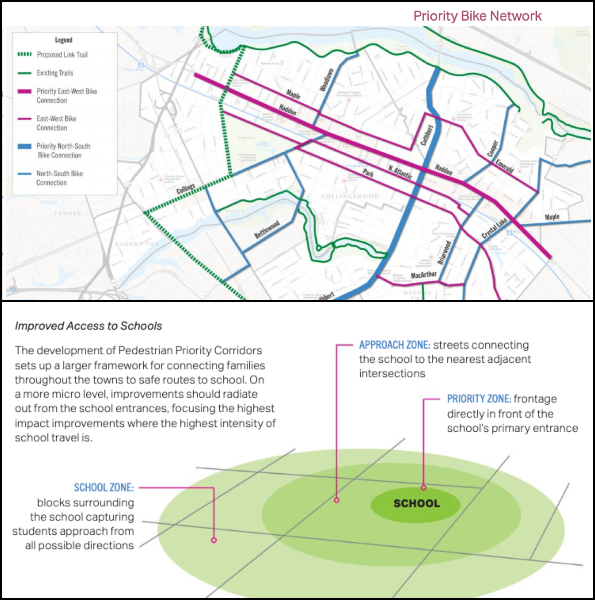
Atlantic Avenue Pedestrian and Bike Access as documented in the Connect 2020 plan. Credit: Matt Skoufalos.
It’s also a school zone, as the Good Shepherd Regional Catholic School is even closer to the site than the Speedline station. If the Collingswood Board of Education bond referendum passes in the fall, North Atlantic could see even more intense use for pick-up and drop-off.
TOD projects focus on planning for infrastructure that supports pedestrian, bike, and e-micromobility “last-mile” access close to mass transit stations like the PATCO stop. There are even federal planning grants available for redevelopment projects that create affordable housing near transit.
The general affordability, or inaffordability, of housing in Collingswood was another topic of conversation at the meeting. Residents talked about whether the senior housing component of the project would be affordable to borough residents looking to age in place, or whether the super-heated local rental market would be cooled at all by the availability of new housing inventory in town.
The whole of the project will include a 15-percent set-aside of affordable housing, which is defined as a percentage of area median income on a sliding scale. The amount of affordable housing in Collingswood that is already age-restricted necessitates that the affordable housing component of the water tower project will not be age-restricted; it will, however, be deed-restricted as affordable for 30 years.
Following the demolition of its public works garage, Collingswood will perform its due diligence to determine whether the site will require any environmental remediation.
Borough commissioners will host a second community visioning session for the project Saturday, June 8, at 10 a.m. in the borough public safety building.

